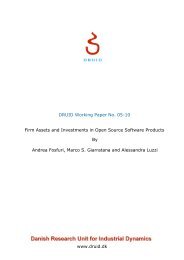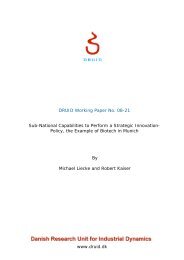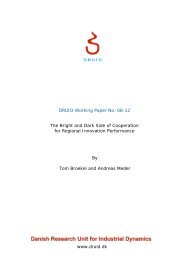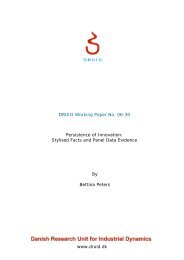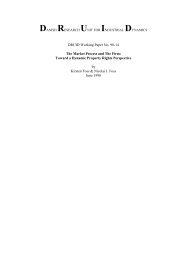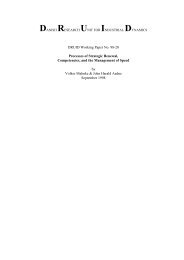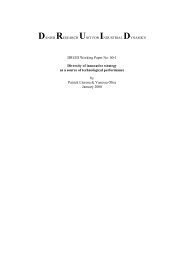danish research unit for industrial dynamics druid working paper no ...
danish research unit for industrial dynamics druid working paper no ...
danish research unit for industrial dynamics druid working paper no ...
Create successful ePaper yourself
Turn your PDF publications into a flip-book with our unique Google optimized e-Paper software.
315. Towards a taxo<strong>no</strong>my of k<strong>no</strong>wledge created in tech<strong>no</strong>logical agreementsOur next step, in this section, is to see more explicitly the link between assets andk<strong>no</strong>wledge produced in agreements <strong>for</strong> going inside the "black box" of the generation ofspecific capabilities with regard to organisational contexts. We try to stretch a taxo<strong>no</strong>my ofk<strong>no</strong>wledge created and to give some elements of interpretation concerning the dynamic oflearning. This taxo<strong>no</strong>my tries to bring some light to bear on the nature of k<strong>no</strong>wledgeaccording the level of codification, the level of diversity, the level of generality and thelevel of centralisation 10 . We look very carefully at the link between the level ofgeneralisation and other kinds of k<strong>no</strong>wledge (according the level of codification <strong>for</strong>example) and try to see if any kind of k<strong>no</strong>wledge has an impact on the exploitation andexploration trade-off supporting the learning process.5.1 Characteristics of k<strong>no</strong>wledge produced* Level of codificationK<strong>no</strong>wledge generated inside the agreement is most of the time both tacit and codified 11 .This k<strong>no</strong>wledge has initially been taught through direct experimentation. After a period ofteaching, some codification has been done. This process is <strong>no</strong>t trivial because roboticproduction is complex and requires different bodies of interrelated k<strong>no</strong>wledge. This level ofcomplexity calls <strong>for</strong> specific procedures in order to codify k<strong>no</strong>wledge without excluding itstacit dimension. In practice we observe that engineers have to have worked together at leastone year in order to explain their own practice and their idiosyncratic needs. After thisperiod of k<strong>no</strong>w-how exchange, some groups try to memorise the shared k<strong>no</strong>wledge through10 The taxo<strong>no</strong>my relies upon a qualitative evaluation of k<strong>no</strong>wledge produced. Empirical facts have beencollected during interviews and update when the organizational entity has been trans<strong>for</strong>med.In<strong>for</strong>mations are used here more to bring some light on the historical perspective of competencies'building than to bring some accurate measures of k<strong>no</strong>wledge created.11 As recognized Senker, in the robotic sector, tacit k<strong>no</strong>wledge coexist most of the time with codificationprocedure because of the distributed k<strong>no</strong>wledge incorporated in each firm. " Limits to codificationexposed by attemps to produce general solutions to automation as shown by the history of <strong>industrial</strong>robots. The original vision <strong>for</strong> this tech<strong>no</strong>logy was the production of a universal replacement <strong>for</strong> humanlabour. In the event, families of different special-purpose robots have emerged, adapted to the needs ofspecific users and specific applications. Moreover, the successful implementation of robots depends on'detailed and specific k<strong>no</strong>wledge about the particular situation in which it is proposed to introduce arobot, and about the tech<strong>no</strong>logy itself" (Fleck, 1983, p. 67); beside being widely distributed throughoutan organisation, much of this k<strong>no</strong>wledge is tacit and uncodified "(Senker, 1993, p.221).



